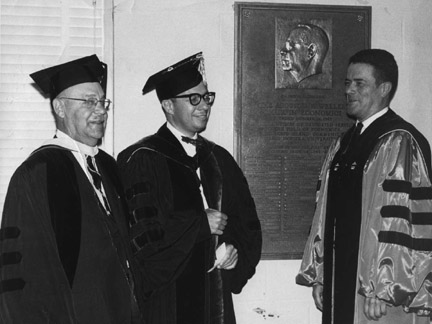A LOOK
BACK: LONG ISLAND’S FIRST RESEARCH CHAIR ANTICIPATED INFORMATION
AGE
Back before satellite antennas
and electronic remotes were household appliances, when wireless services were
something out of a James Bond movie, Meadow Brook National Bank Chairman and
Hofstra Trustee Augustus B. Weller created the first research chair on Long
Island, which helped pioneer allocation and use of the airwaves. The fully
endowed Augustus B. Weller Chair in Economics at Hofstra University was
commemorated at a testimonial dinner at the Garden City Hotel on October 24,
1963. Before the century was through, the research generated by the chair
inspired the U.S.
Telecommunications Act of 1996, allowing the U.S. to realize the
full potential of the information age.
In
establishing the Weller Chair, Hofstra’s Board of Trustees raised $400,000 from
Long Island’s business community. On September 23, 1964, the Board awarded the
chair to Professor Harvey J. Levin, then chairman of the university’s Economics
Department and a lifelong resident of Long Island, who held it for its first
twenty-five years.
"A kind and generous
lady who lived in our Village of Westbury, and who had a considerable curiosity,
had apparently been bombarded with innumerable inquiries about what had
happened. Finally, she wrote to my wife. 'Dear Rhoda,' she said,
'We've all been reading in the newspapers about Hofstra's new Chair.
Everyone's talking. It just sounds wonderful -- congratulations!
What is it?"
-- Harvey J. Levin
upon receiving the
Weller Chair, September 23, 1964
(from An Act of Community
Faith: The Founding of the Weller Chair)
Allowing him
to spend half his time performing research, funded by think tanks like Resources
for the Future (RFF), the chair supported Dr. Levin's groundbreaking study
anticipating the evolution of television, satellites, cellular telephones,
remotes and wireless internet, and their demands on increasingly congested
airwaves.
The wireless "shoe-phone" in
television's Get Smart, circa 1965
At a time when cell phones were
considered a joke and existed only in secret agent Maxwell Smart’s “shoe phone”,
the chair-sponsored study was considered "far out" even by one of RFF's own
trustees. Most observers didn't even consider the airwaves a resource, and
some likened the study's "far-fetched" concerns to those in "Star Trek".
However, the study's publication, The Invisible
Resource – Use and Regulation of the Radio Spectrum,
pioneered the field of communications economics. It also inspired the
Federal Communications Commission’s equitable diversification of the airwaves,
when the U.S. began auctioning off broadcast frequencies in 1995, culminating in
the 1996 Telecommunications
Act.
Today Hofstra’s Weller Chair continues to support
economic research and publication. Its history is archived at the
university's Archives,
which includes the Harvey
J. Levin Papers.
 Augustus B. Weller (left) and Hofstra President Clifford Lord (right)
present the Weller Chair to Dr. Levin (center). "It is personally
gratifying to me that in Dr. Levin, we have found not only a young scholar who
already has anational reputation, but one of our own -- a Long Island
resident and a dedicated Hofstra teacher," said Mr.
Weller.
Augustus B. Weller (left) and Hofstra President Clifford Lord (right)
present the Weller Chair to Dr. Levin (center). "It is personally
gratifying to me that in Dr. Levin, we have found not only a young scholar who
already has anational reputation, but one of our own -- a Long Island
resident and a dedicated Hofstra teacher," said Mr.
Weller. In his address
to the Hofstra and Long Island community that day, Dr. Levin shared the
following observations in accepting the chair which, like the chair-sponsored
study itself, were proven correct some thirty years later.
| Bear in mind at least that businessmen, like members
of other groups and professions, are shaped by culture and society as much
as they in turn influence them; that their habits of thought are deeply
ingrained; that thinking one way in the rigors of the marketplace, it is
not always easy to think in other terms in the crucial area of educational
investment. Yet, our donors have done just that, by acting here not along
traditional lines of economic calculation narrowly viewed, weighing off
dollars invested against expected financial returns. Rather they have
acted on the basis of a faith – a faith in our dual system of education,
and in the judgment and capacities of Hofstra University. Above all, they
have shown the most crucial of attributes – a mature willingness to settle
for returns on their investment of a far more elusive, but I believe,
fundamental sort, than financial returns in the marketplace. But returns
there will be – make no mistake about that – if we jointly broaden our
sights and release our imaginations to identify them.
|
(From An Act of Community
Faith: The Founding of the Weller Chair, Hofstra University, 1964)
[Weller
Chair archives]

